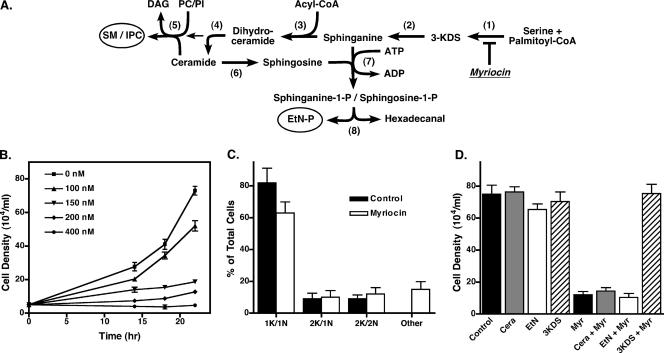FIG. 1.
Cell growth is inhibited by myriocin. (A) The sphingoid lipid pathway. Enzymes are indicated by numbers in parentheses as follows: (1), serine palmitoyltransferase; (2), 3-ketosphingosine reductase; (3), dihydroceramide synthase;(4), dihydroceramide desaturase; (5), “sphingolipid” synthase; (6), ceramidase; (7), sphingosine kinase; (8), sphingosine-1-phosphate lyase. Final end products are sphingomyelin (SM), inositol phosphorylceramide (IPC), and ethanolamine phosphate (EtN-P). Other abbreviations are 3-ketodihydrosphingosine (3-KDS), phosphatidylcholine (PC), phosphatidylinositol (PI), and diacylglycerol (DAG). The site of inhibition by myriocin is indicated. (B) Bloodstream cell cultures were seeded at 1 × 105 cells/ml in the presence of the indicated concentrations of myriocin, and densities were counted at the indicated times. Means ± standard deviations of triplicate cultures were determined. (C) Fixed and permeabilized bloodstream cells were stained with DAPI to reveal the localization of the nucleus and kinetoplast. The numbers of nuclei and kinetoplasts per cell were counted (n = 100) for myriocin-treated (200 nM, 18 h) and control cultures. Data are means ± standard deviations from three independent experiments. (D) Bloodstream trypanosomes were seeded at 1 × 105 cells/ml and grown for 18 h in the presence or absence of 200 nM myriocin with additional supplementation with either 2.5 μM 3-KDS, 10 μM ceramide (Cera), or 100 μM ethanolamine (EtN). Values are means ± standard deviations from triplicate cultures.

